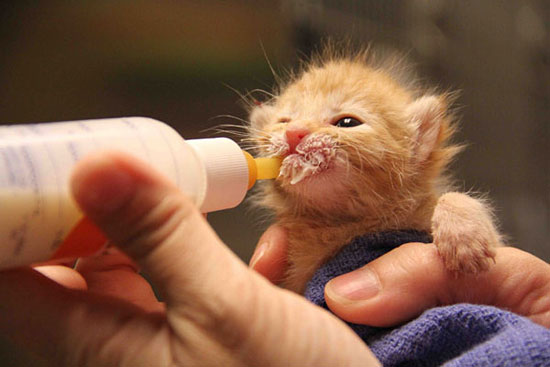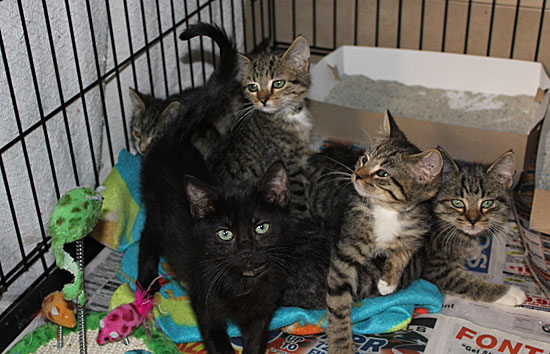Saving animals by the numbers
January 23, 2014

Better data can lead to programs to save the lives of kittens, like this one in a new Mission Hills “nursery.”
Furry pet faces never fail to tug heartstrings, but when it comes to animal welfare, numbers don’t lie: Last year, some 79,150 cats, dogs and other pets ended up in Los Angeles County animal shelters, and fewer than half of them made it out alive.
That, believe it or not, is actually good news. Five years ago, the euthanasia rate in county shelters was 65%. But while most people know that pet adoptions and spaying, neutering and licensing are all acts of kindness, nothing drives home the point like the hard facts.
That’s why the county Department of Animal Care and Control has gone online with its statistics.
“Our biggest hope is that people will see these numbers and realize not only that the department is doing great work, but also that this really is serious. Spaying and neutering and keeping pets secured so they don’t end up in shelters is really important,” says Betsey Webster, chief deputy director of Animal Care and Control for the county.
“These animals end up with us as a result of human behavior. Some people just don’t understand, but some of it also is just irresponsible ownership.”
Department Director Marcia Mayeda says the new stats pages, which went up in late December, were on her to-do list for a long time, but couldn’t be implemented until the department upgraded its 13-year-old web site. Though animal control data have always been a matter of public record, until now, people had to call or email the department and request them.
“Other agencies put their statistics online, but we wanted to do more than just put up spreadsheets,” says Mayeda. Working with the county’s Internal Services Department, her team spent about six months turning its raw numbers into colorful graphics and pie charts that demonstrate the scope and the challenges of animal welfare in the county.
For instance, Mayeda offers this disturbing data point: Only a quarter of the nearly 30,000 cats that ended up in county shelters last year escaped euthanasia, and only one in 100 was returned to an owner.
“The No. 1 reason why an animal dies in our shelters,” she says, “is because it’s a feral cat.”
For dogs, on the other hand, the picture is much more optimistic. Only about 35% of the county’s 41,500-plus shelter canines had to be euthanized last year.
“When I started in 2001, our euthanasia rate for dogs was about 66%,” says Mayeda, noting that 60% is still the national average. “But we’ve made tremendous inroads. We’ve worked closely with more than 200 animal rescue groups. We do pet transport, where groups will take 30 or 40 dogs at a time to other parts of the country where there’s a demand for adoption.
“And we’ve gotten a lot more volunteers in the last 10 or 12 years, who have helped us with finding pets homes through offsite adoptions. A lot of people don’t want to go to shelters because they’re afraid it’ll be too sad for them, so we’ll take 10 or 20 dogs to a PetSmart, and people will come and adopt them. All of it has really pulled down our euthanasia rate.”
Marc Peralta, executive director of the Best Friends Animal Society in Los Angeles, which has worked with the City of Los Angeles to reduce the kill rates of healthy, treatable animals in its shelters, applauded the county’s efforts. Good animal control data, he says, can literally mean the difference between life and death for lost, abandoned or homeless pets.
Though some shelter animals will inevitably be put to sleep—vicious dogs, for example, or pets who are too old, ill or feral to be feasibly adopted—many end up being euthanized merely because public shelters have limited space but are forbidden by law to turn any stray away.
“In Los Angeles’s city shelters, one of the first things we noticed was that something like 6,000 of 13,000 cat euthanasias were neonatal kittens,” says Peralta. The baby cats were too young to be spayed or adopted, he recalls, but the city shelters weren’t equipped to provide intensive bottle-feeding to that many kittens without badly neglecting their other charges.
So last year in Mission Hills, Best Friends and the No Kill Los Angeles animal welfare coalition jointly opened a neonatal kitten nursery.
“We thought, if we can get those newborns to two months, who doesn’t want to adopt kittens?” That initiative alone, he says, has saved thousands of cats from euthanasia. “All that was based on data from shelters,” he says. “It helps us know where to point the guns.”
Mayeda says the department is hoping over time to deepen their online statistics, which currently focus on overviews and shelter-by-shelter outcomes in the county’s six regional shelters. Those numbers in themselves are eye-opening—pets in the county’s Agoura shelter, for instance, are about twice as likely to be adopted or returned to their owners as are pets in the much-larger Downey shelter.
But Mayeda says she also wants to drill down on the feral cat outcomes so that the public better understands the urgency of the problem.
“A lot of people will say, ‘There’s this cat in my yard and I don’t mind putting out food, but she keeps having kittens and they get hit by cars or beaten up by tomcats.’ Well those people mostly don’t want to spend $300 to take that cat to a veterinarian and have it spayed, but a feral cat is like a raccoon—you can’t really adopt it.”
In fact, she notes, the county offers discounted services for senior and low-income pet owners, and animal welfare groups such as the Spay Neuter Project of Los Angeles will spay or neuter a “community cat,” as they call feral felines, for as little as $25. But many people are unaware of those services and believe that a trip to a vet is the only option.
“So people end up bringing it to the shelter, where our only option is to euthanize it. But if they were to see the numbers, and if there were, say, a big push for free or low-cost spaying and neutering and a program they could go to, well, that would be one less cat that we’d have to put to sleep.”
In the meantime, Webster and Mayeda say, pet owners can take advantage of the vaccination, licensing and microchipping services offered at shelters countywide. Currently offered on various weekdays at the shelters, the services will gradually shift this year to alternate Sundays from 10 a.m. to 3 p.m. (Click here for the current microchipping schedule, and here for information on the new Sunday clinics.)
“Microchipping is mandatory in unincorporated Los Angeles County,” Webster points out. “But it’s also great because an animal that is microchipped can make it home without entering the shelter at all.”
Posted 1/8/14













 405 bridge work causes a stink
405 bridge work causes a stink





